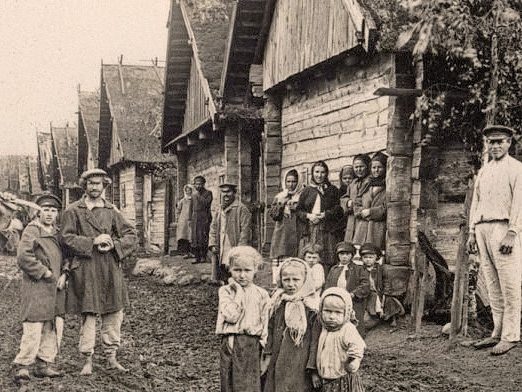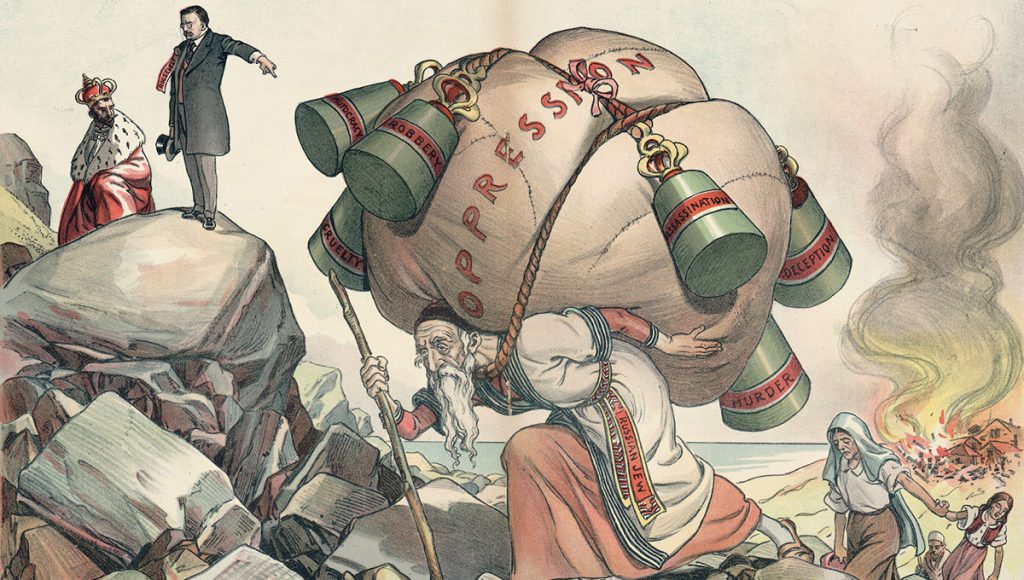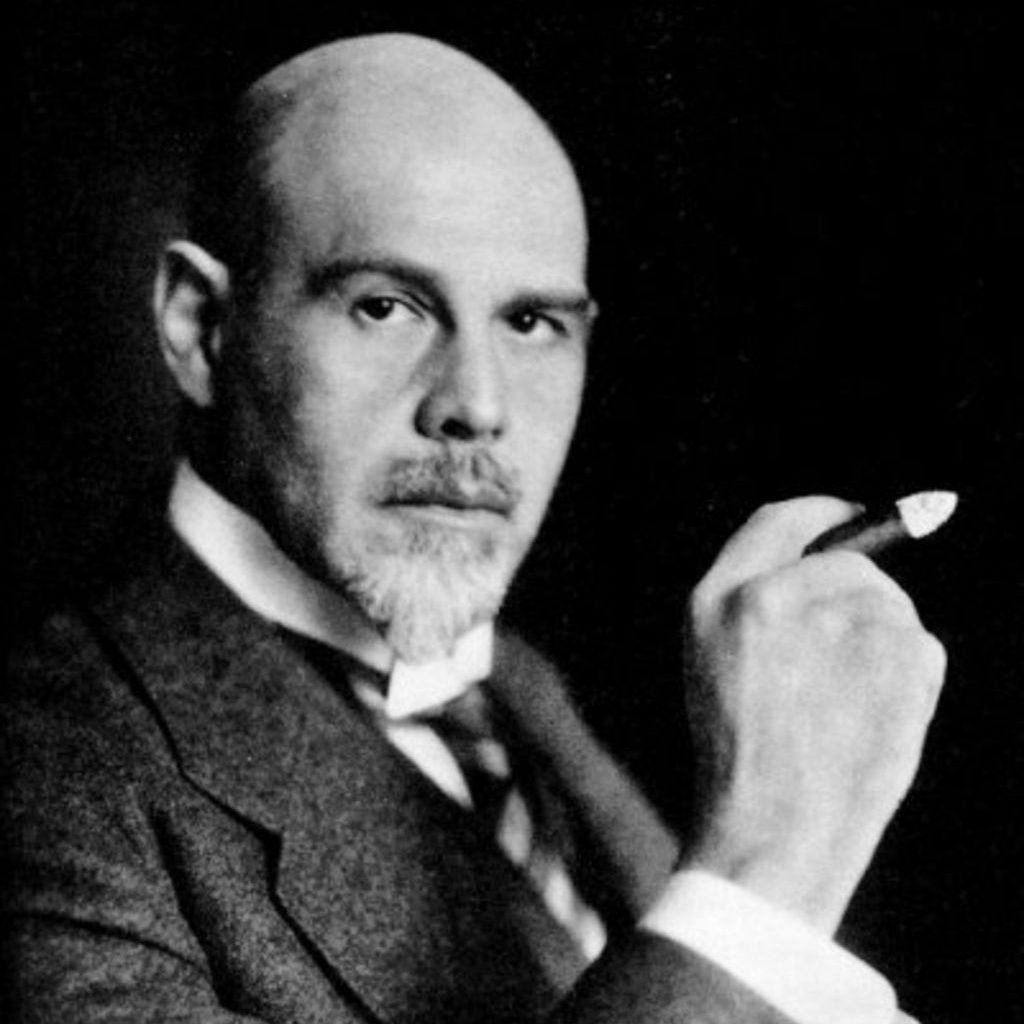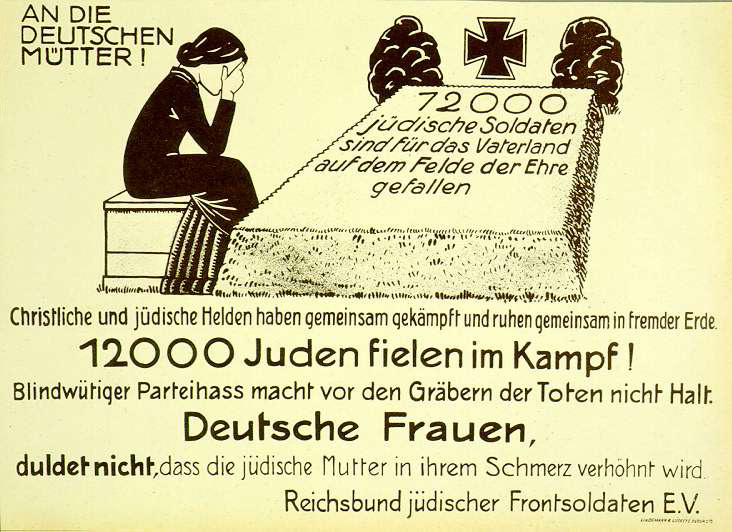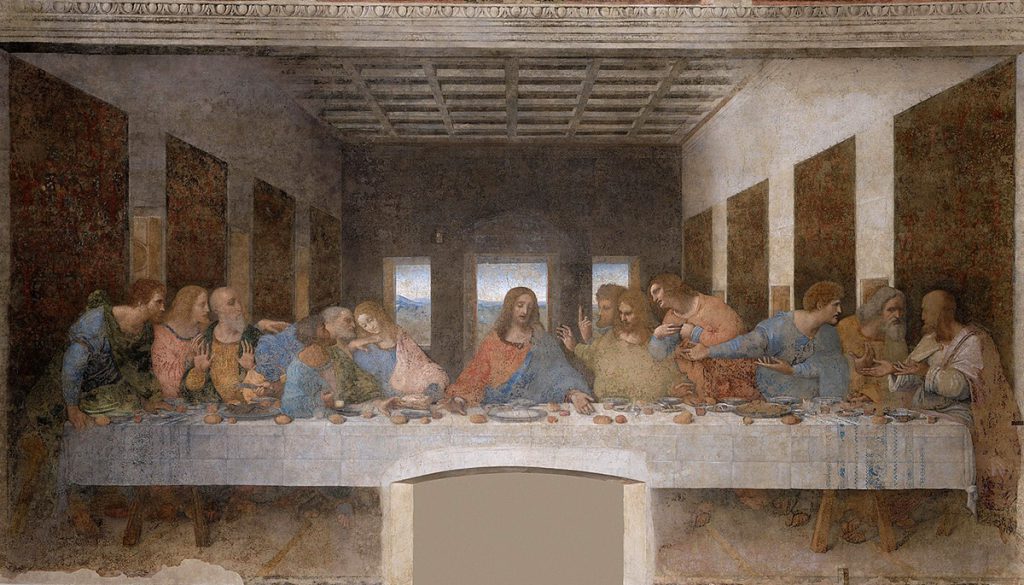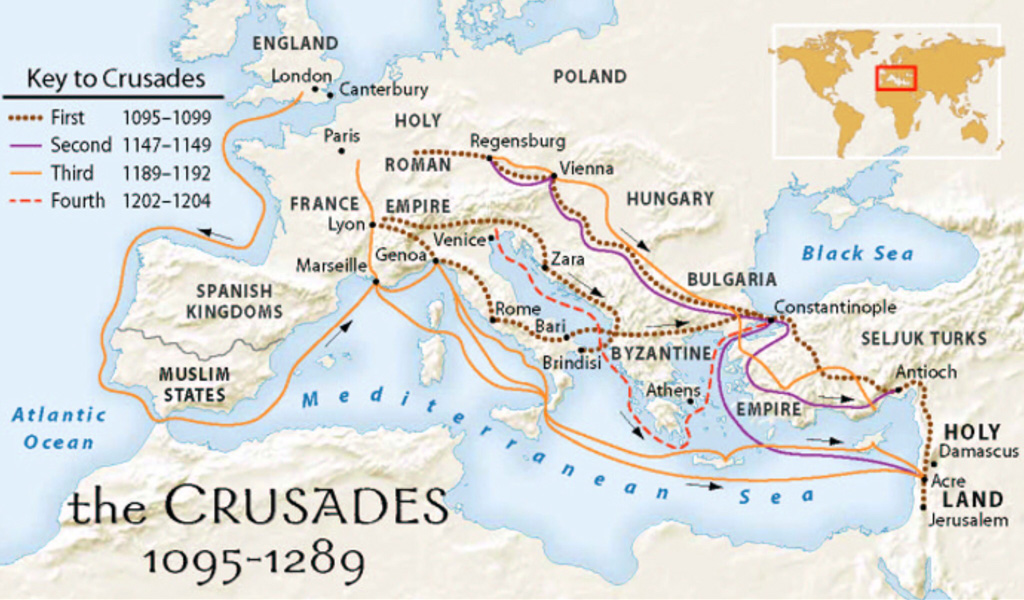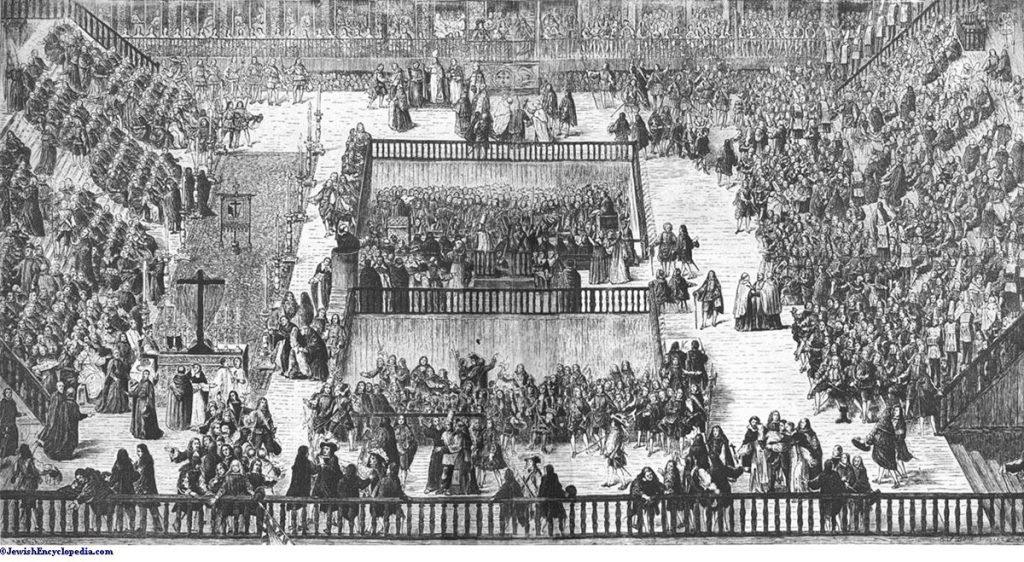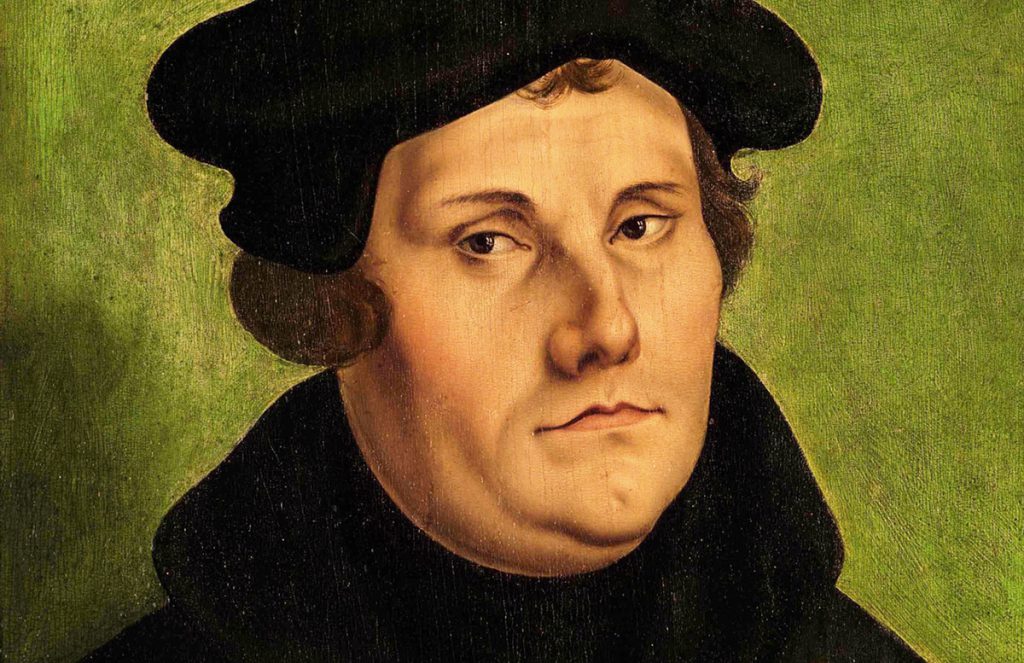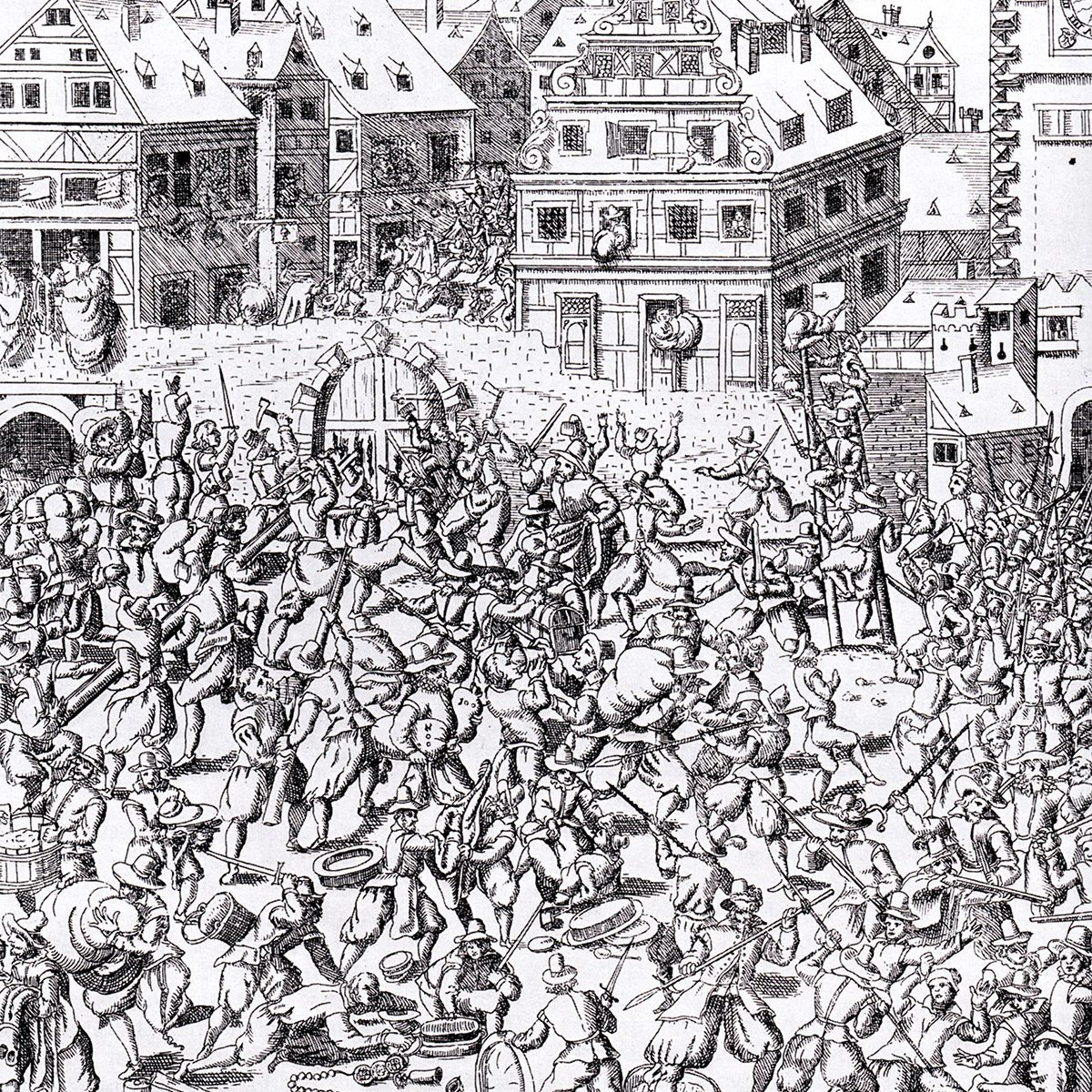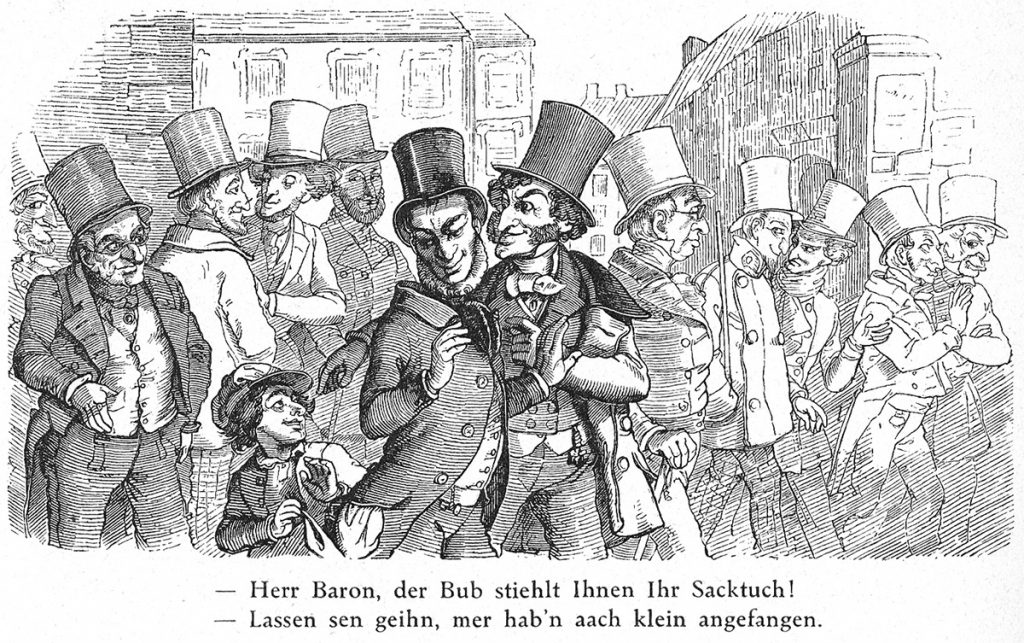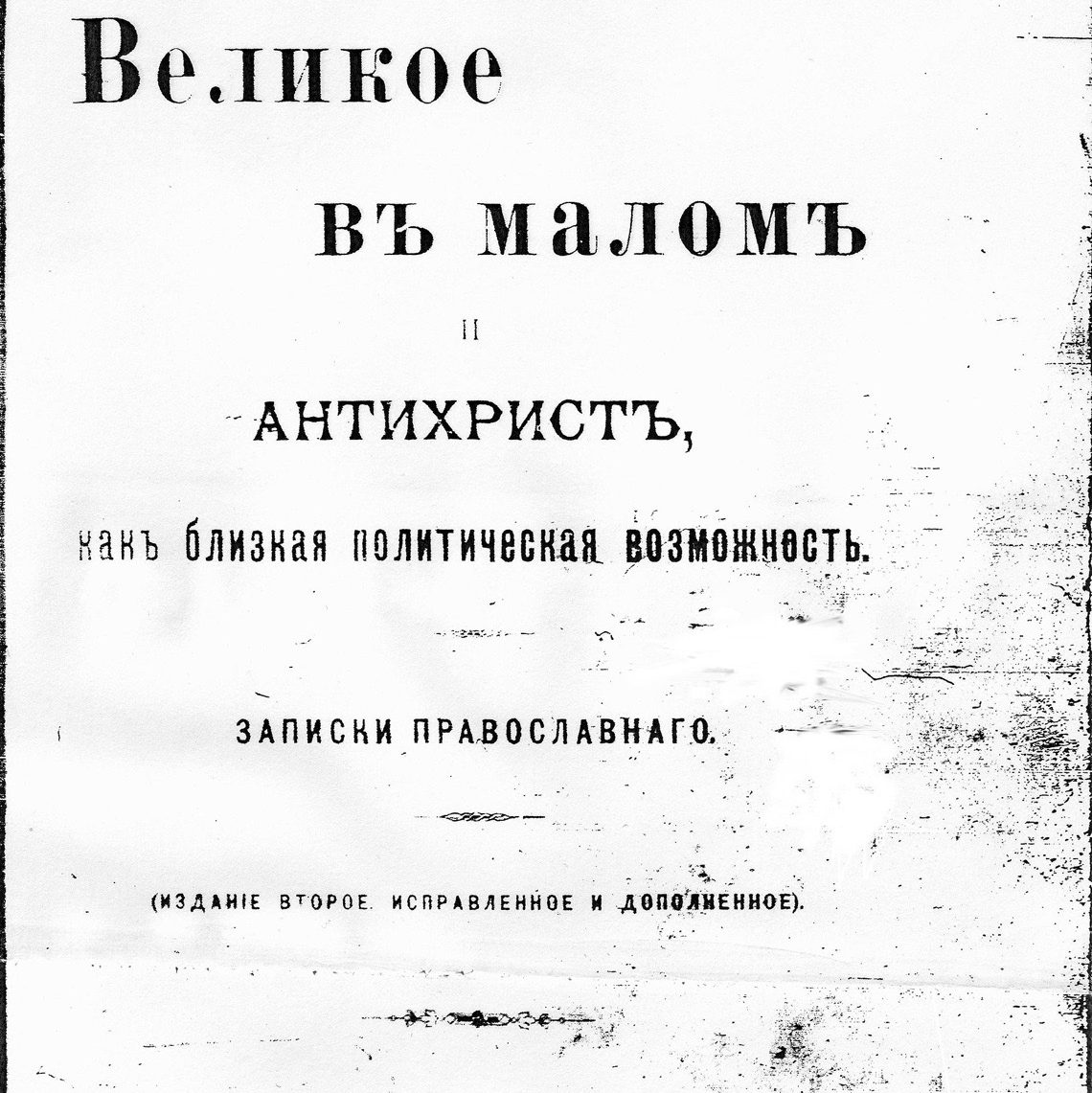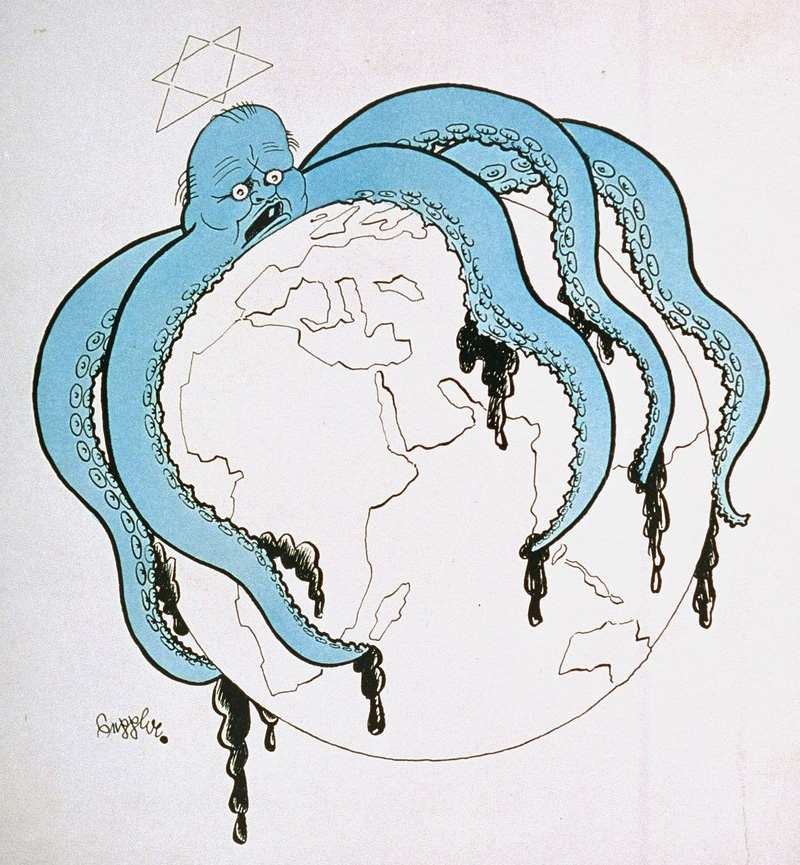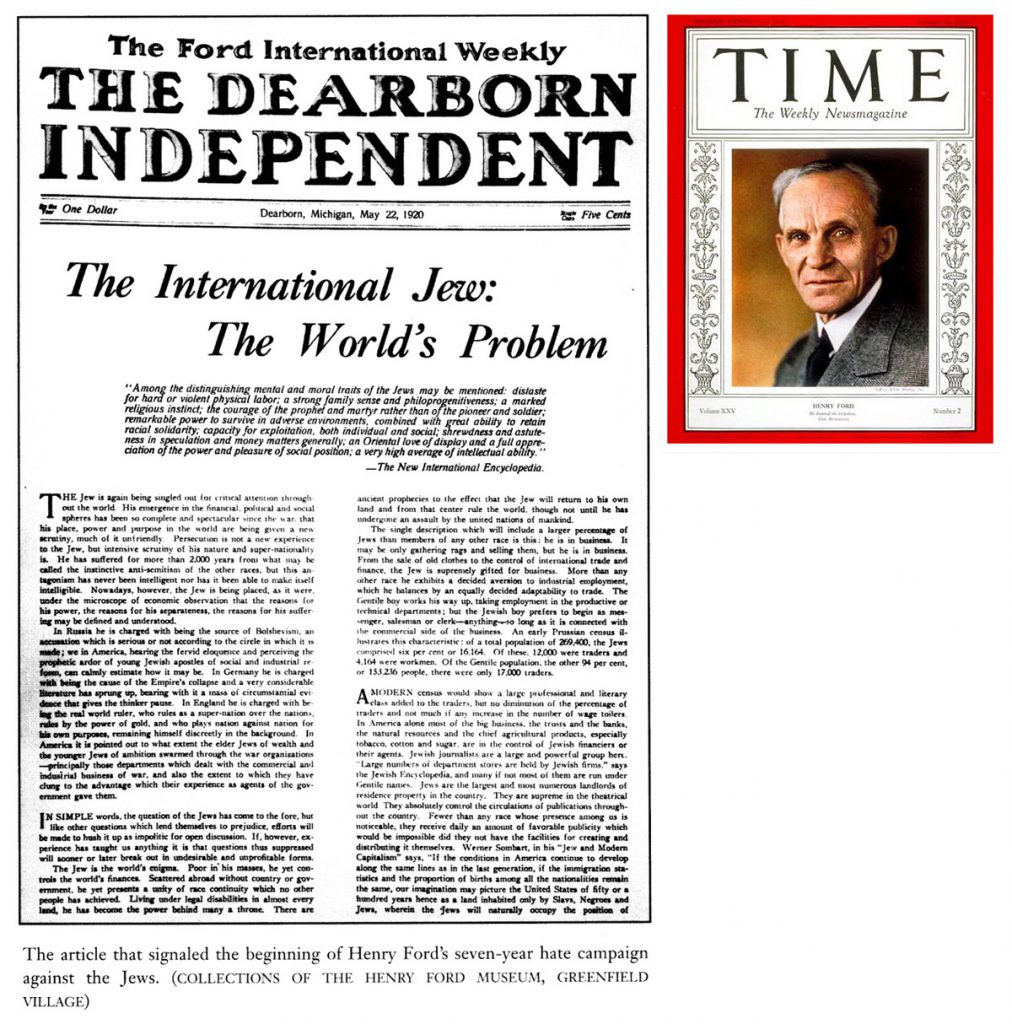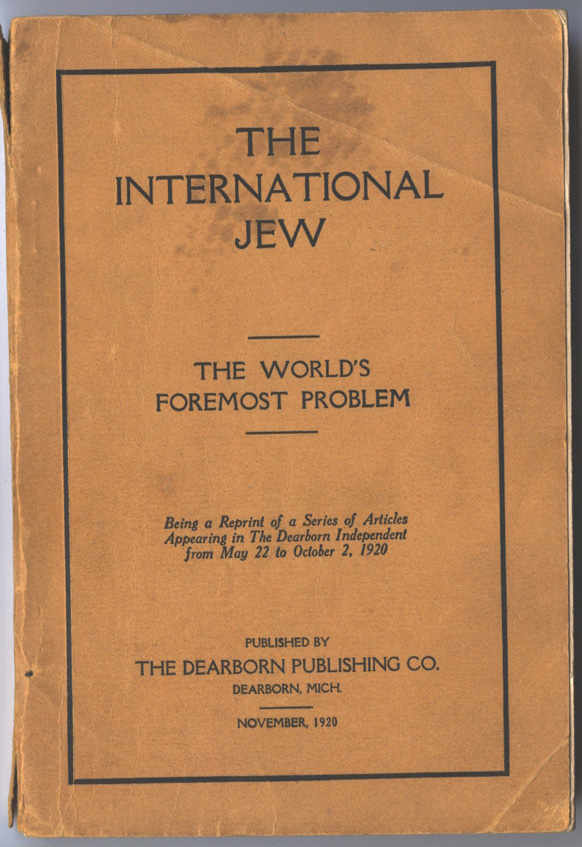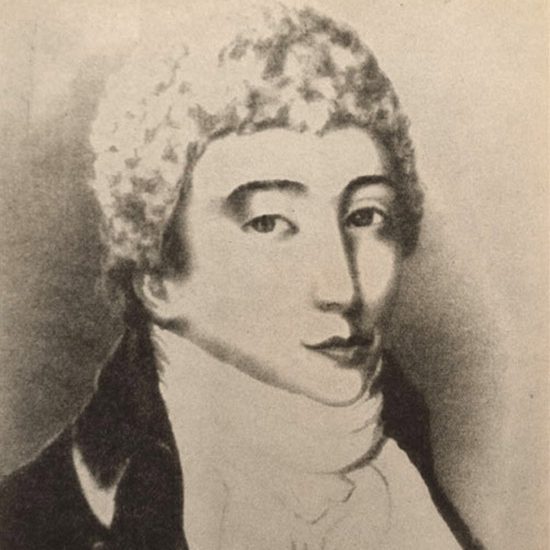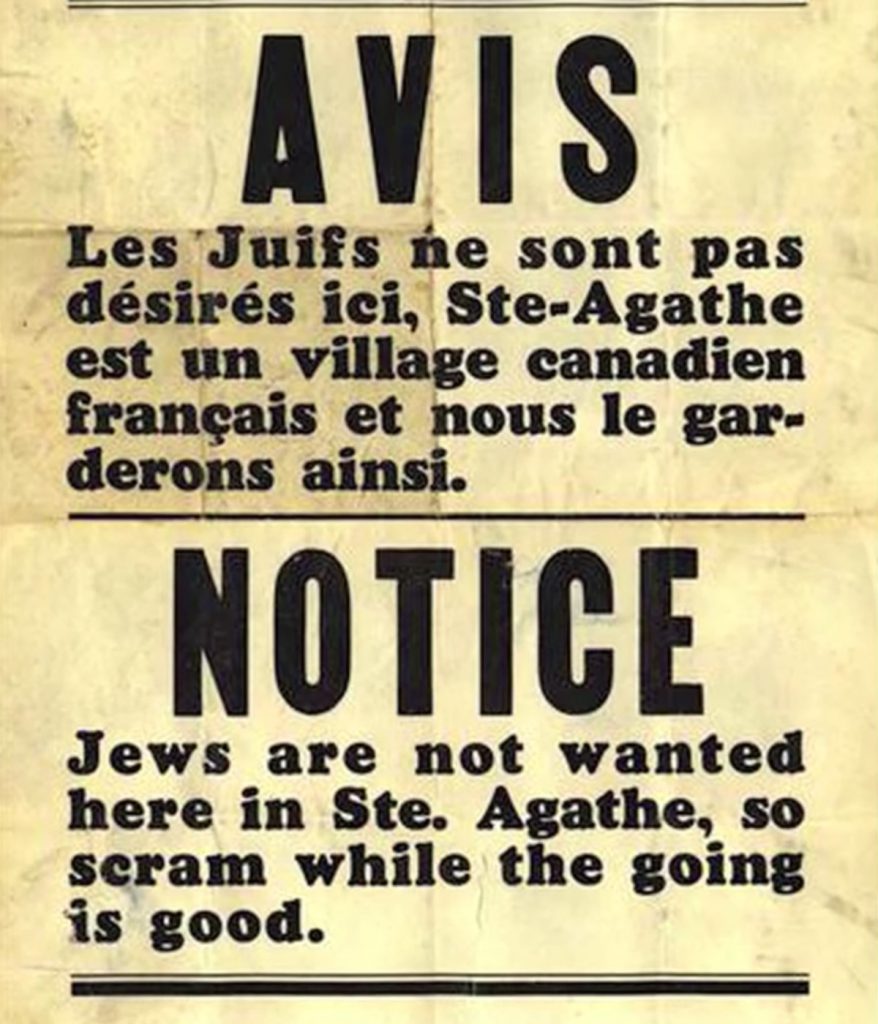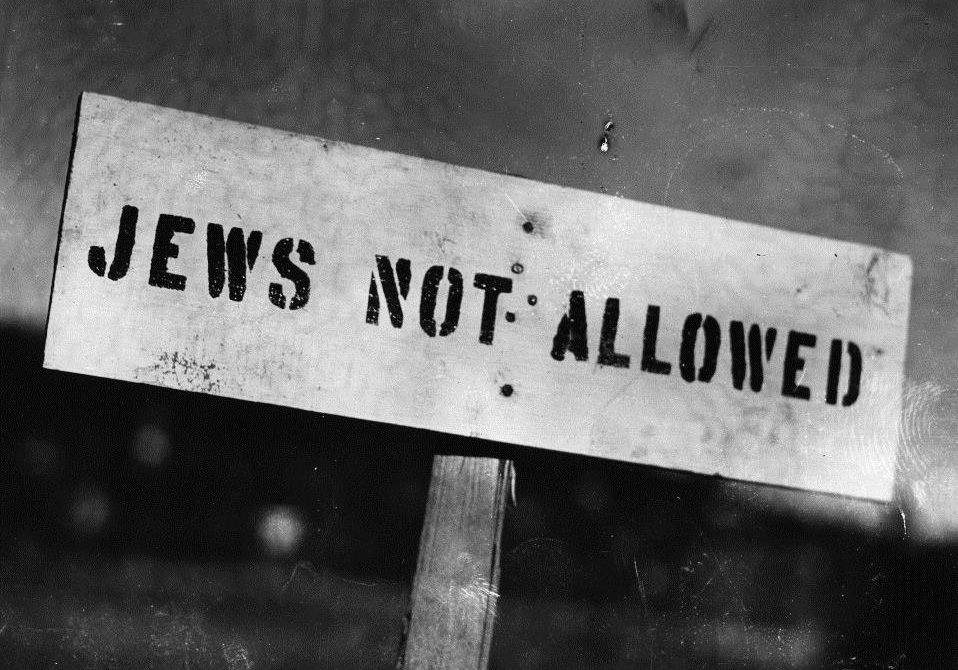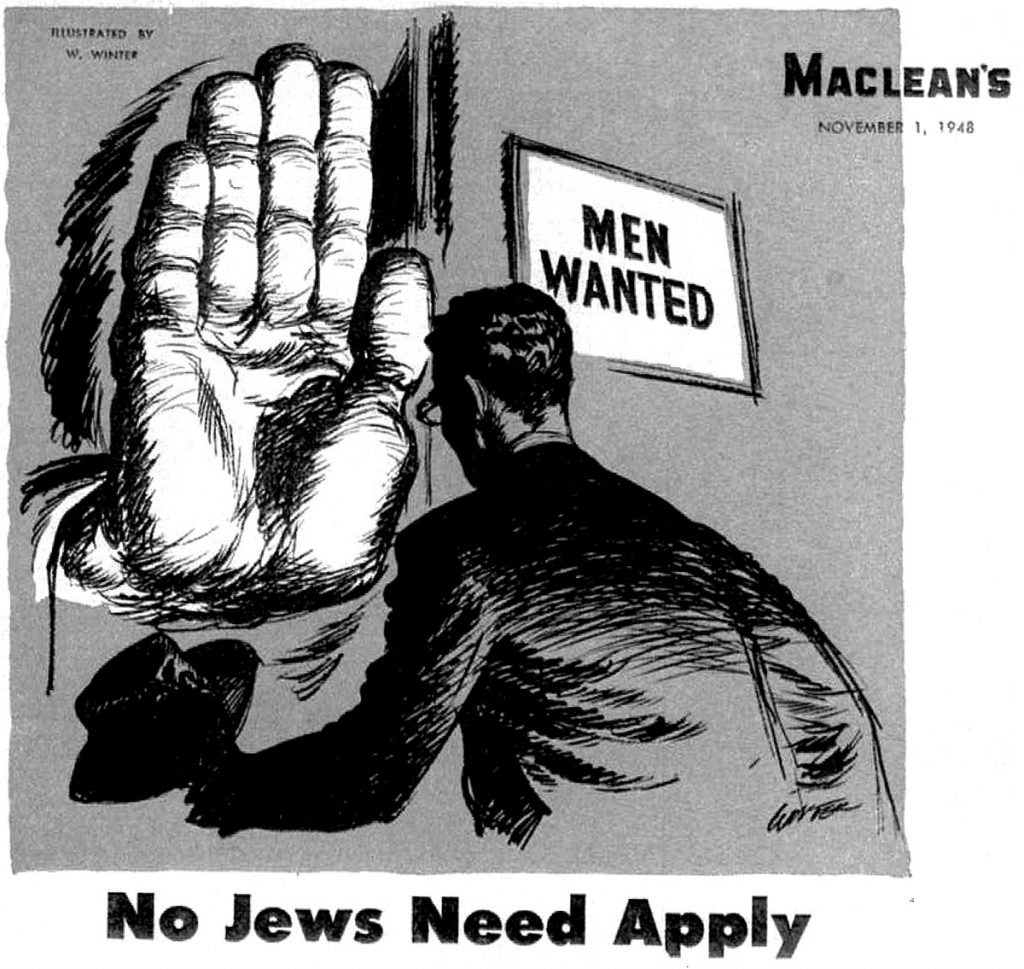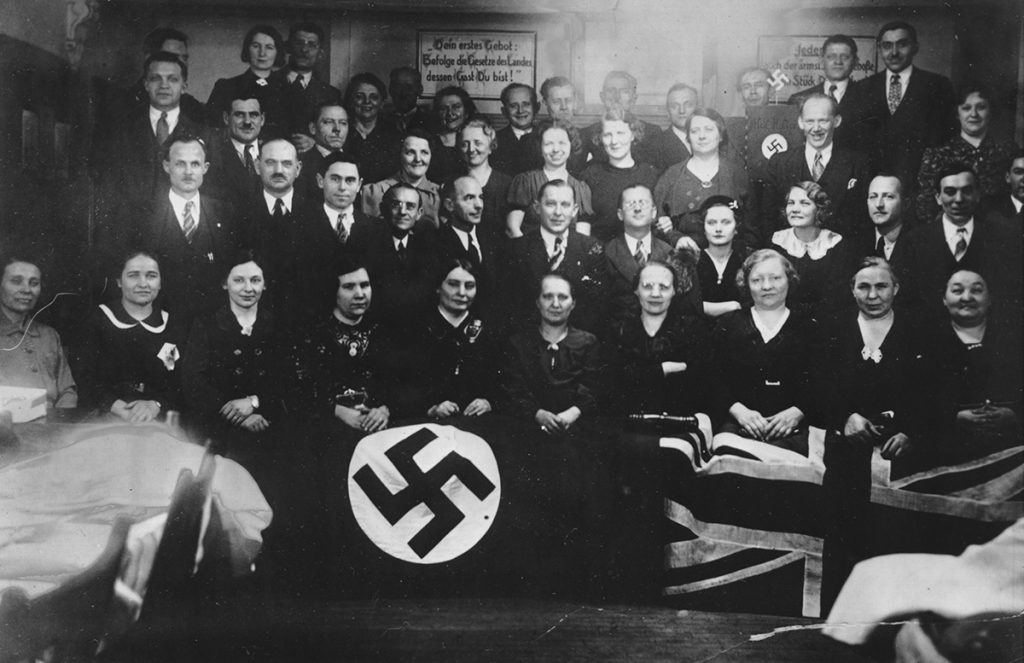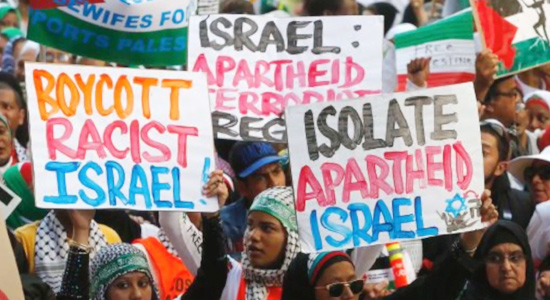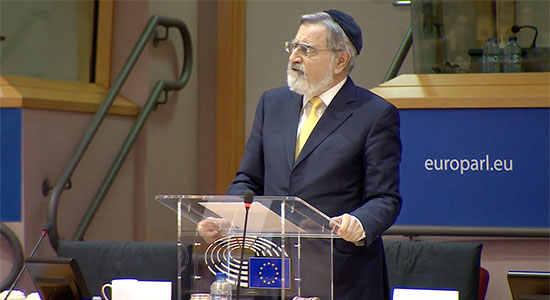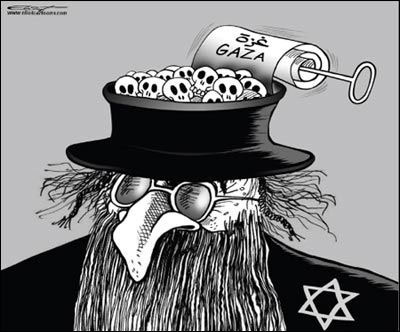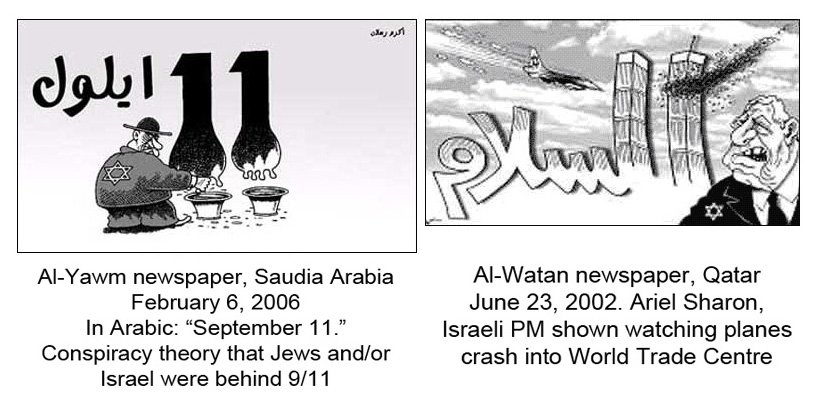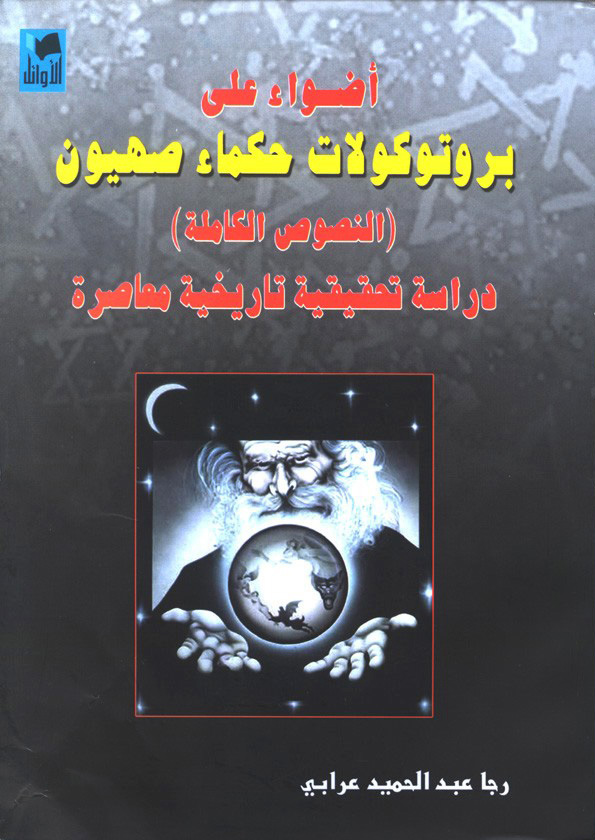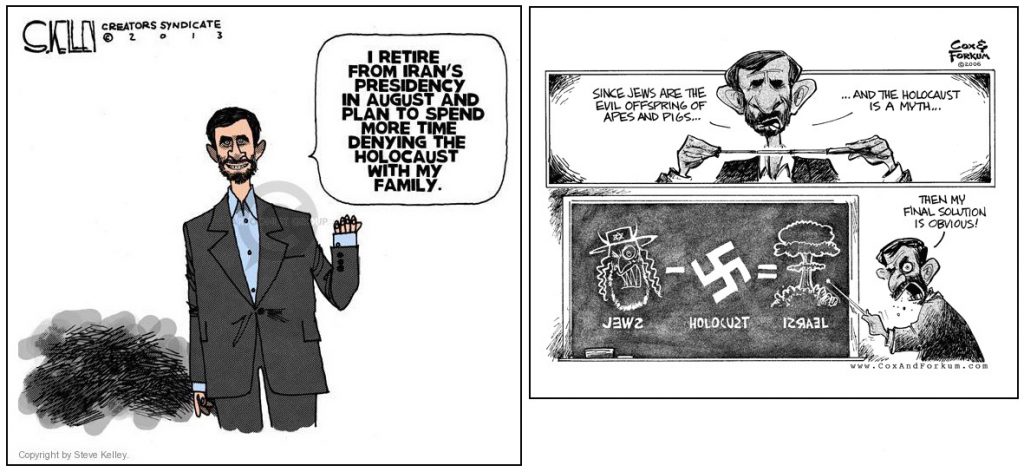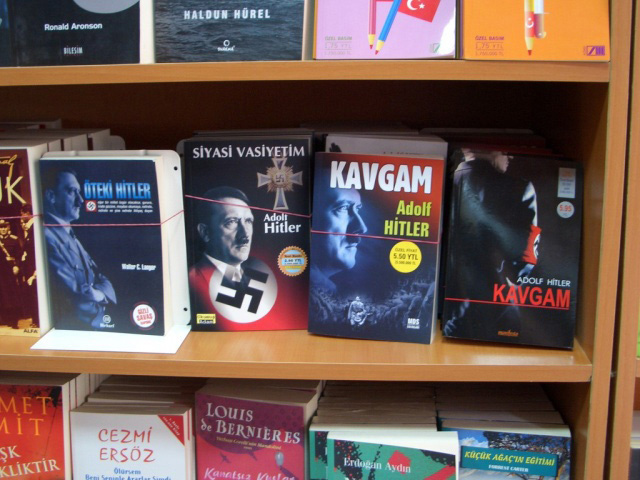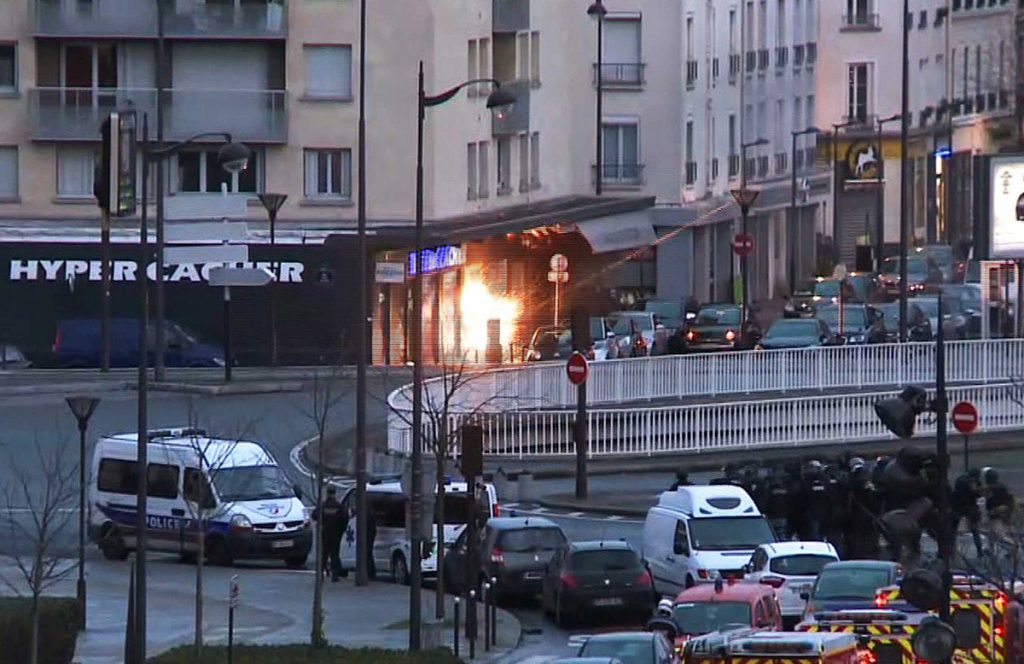|
Unit 3: Prejudice and Discrimination
Chapter 5: Antisemitism
 |
||||||||||||||||||||||||||||||||||||
Educator ToolsNote to Users: This page is under reconstruction. Thank you for your patience.
|
||||||||||||||||||||||||||||||||||||
| Source: Jewish Data Bank 2019 | ||
| Country | Core Jewish Population | Percentage of Total Jewish Population |
|---|---|---|
| Israel | 6,665,600 | 45.3% |
| United States | 5,700,000 | 38.8% |
| France | 450,000 | 3.1% |
| Canada | 392,000 | 2.7% |
| United Kingdom | 292,000 | 2.0% |
| Russian Federation | 165,000 | 1.1% |
| Argentina | 180,000 | 1.2% |
| Germany | 118,000 | 0.8% |
| Australia | 118,000 | 0.8% |
| Brazil | 95,200 | 0.6% |
Jewish Life Before the Second World War
Two streams of European Jews;
- East: Russian, Poland and the Ukraine
- West: Germany, France and England
Early 1900s, a poor Jewish village in Poland, known as a shtetl
Photo credit: https://www.apartfrommyart.com/from-shtetl-to-jello/
 Definitions
Definitions
Pogrom
Russian word meaning “to destroy, demolish”. This term is used in English to refer to collective violence, usually against Jews but has also been used for violence against other ethnic minorities.
The East – Russia:
Fiddler on the Roof is a popular musical and film based on short stories by Sholem Aleichem. It is fiction however, a very fond looking back, and should never be taken as history any more than watching Guardians of the Galaxy and thinking that is what life will be like for your grandchildren. This very large group of about 5 million Jews in Russia was extremely religious and superstitious. Their life rotated around their faith and their rebbe (teacher). Jews were not allowed to own lands or have jobs outside of their little village. Tradition was important and life was precarious.
- Eastern European market towns, almost completely Jewish communities (Ashkenazi), located in Poland and Russia
- Started around 1200, ending in the Second World War
- About 85% of the 5 million Jews spoke their own language called “Yiddish” with roots in High German mixed with some Hebrew, Aramaic, Turkic, Slavic and Romance languages
- From 1790s to 1915 under Russian Empire control
- Russian “Pogroms” in 1880s led to emigration of up to 2 million Jews from Eastern Europe
- Strong sense of community
- Followed the rules in the Torah
- Jewish education, mostly for the boys
- During the Holocaust, Nazis exterminated all the Jews in the communities or villages called shtetls
The Jews were extremely poor and life was difficult. The Jewish calendar of holidays was central to life and every Jew kept a strictly kosher diet. There was tremendous social pressure to be observant. No one worked on the Sabbath, all the men went to the synagogue, marriages were arranged, and life was short and basically unpleasant. On the other hand, music and religious instruction (not much art, drama) were important. From time to time, there were very violent attacks called “pogroms” (definition below) on Jewish settlements by the army or armed groups who had the government’s support.
From 1791 to 1835, The Russian Empire gained new territory known as the Pale of the Settlement and prohibited Jews from settling in Russian territory outside the Pale. The region included parts of present-day Lithuania, Belarus, Ukraine, Moldova and Poland. Russian pogroms by non-Jews began in 1881 in Elizavetgrad (present-day Ukraine) and spread through seven provinces in southern Russia and Ukraine. Jewish stores and homes were looted, their property destroyed, women were raped and many Jews were beaten or murdered. Regardless of whether or not the government ordered these attacks, the response to stop them was slow, with the military or police often joining the violent mobs.
Anti-Jewish laws by the Russian government in the 1880s:
- Limited the number of Jews who could attend high schools and universities
- Prevented Jewish law school graduates from joining the bar
- Restricted where Jews could live
- Non-Jews prohibited from issuing mortgages to Jews
- Jews prohibited from doing business on Sundays
Why were there pogroms and antisemitic laws?
- Jews blamed for the bad economy and political instability
- The blood libel myth that Jews murder Christian babies and bake their blood into their matzah
- Claim that Jews murdered Jesus
- There was a rumour that Jews were involved with the assassination of Czar Alexander II in 1881 by members of the Narodnaya Volya socialist movement.
Jewish Response: Jews fled to Western Europe, the United States and Israel, which at that time was ruled by the Ottoman Empire. Some Jews became politically active, joining the General Jewish Labor Bund, Bolshevik groups and self-defense leagues or becoming Zionists.
1903-1906 Pogroms – in Kishinev (present day Moldova), hundreds of homes and businesses destroyed and dozens of Jews killed, causing tens of thousands of Jews to flee
1905 Odessa – about 2,500 Jews killed
1919 – in Kiev, Cossacks, fearless and brutal fighters within the Russian military, led pogrom injuring and raping many and killing 14 Jews.
The West – Germany
Walther Rathenau (1867 –1922)
A German Jewish industrialist, politician, writer, and statesman who served as Foreign Minister of Germany during the Weimar Republic. He was assassinated on June 24, 1922, two months after the signing of the Treaty of Rapallo between Germany and Russia.
Photo credit: Getty Images
Laws that were favourable to Jews were passed in the early 1800s but by 1850, the 24 kingdoms that spoke German were starting to unify under the concept of a nation, and Jews were not welcome. Germany had very hierarchical societies; everybody had their place, like at Downton Abbey: at the top – aristocracy, then below that, wealthy families, then a rising middle class, then the poor, at the bottom. In Germany, there was a large Orthodox Jewish community who were the face of Jews. Men always wore hats or a kippah, women wore long dresses, and there was little intermarriage. If you married a non-Jew, your family would go through all the same rituals as if you had died and would never speak to you again.
There was a large Reform community in Germany and they were very assimilated by the late 1800s. Assimilation was a big problem for the Jewish community. Jews were giving up everything that made them different and trying to have social lives with non-Jews. Wealthy bankers held music “salons” that included Jews and non-Jews. Antisemitism was an issue but not in polite company. Some Jews did very well, for examples: Albert Einstein and the Rothschilds. Germany’s Foreign Minister in the 1920s, Walter Rathenau, was Jewish (see image above).
The First World War
Printed Leaflet in Germany 1920 – (translated)
“12,000 Jewish soldiers died on the field of honor for the fatherland.”
“Christian and Jewish heroes fought together and lie together on foreign soil.”
“12,000 Jews fell in battle.”
“Blind, enraged Party hatred does not stop at the graves of the dead.”
“German Women: Do not allow the suffering of Jewish mothers to be mocked!”
Source: The Reich Association of Jewish Veterans [Front-line Soldiers]
Many Jews fought for Germany in the First World War, were decorated war heroes who loved their country and felt that Germany was the leader in the world for all the good things. They were convinced that their military service would make Jews more accepted but clearly this wasn’t true in the years leading up to the Second World War. 12,000 German Jews died for their Fatherland (Germany) in the First World War.
ACTION 4
Discuss
Understanding history
With a partner, discuss the history of the Jews leading up to the Second World War. What did you learn that surprised you? Why did it come as a surprise? Discuss the specifics of Judaism and its history – what is of interest? Why? Can you sense a divide between Jewish people and people of other cultures and religions? Can you understand how persecution of Jews was justified throughout history? Explore these questions with your partner then discuss as a class.
History of Antisemitism
Religious Antisemitism
In the past, Christians have had an issue with Jews because they believed Jews murdered Jesus, and also because Jews refused to accept Christianity. Similarly, many Muslims, in the past and many currently, are antisemitic because Jews do not accept Islam.
Christian antisemitism began in the centuries after Christ died. John Chrysostom (344-407 CE) was one of the “greatest” of church fathers, known as “The Golden Mouthed.” This missionary preacher, famous for his sermons and addresses, stated:
The synagogue is worse than a brothel…it is the den of scoundrels and the repair of wild beasts…the temple of demons devoted to idolatrous cults…the refuge of brigands and debauchees, and the cavern of devils. It is a criminal assembly of Jews…a place of meeting for the assassins of Christ… a house worse than a drinking shop…a den of thieves, a house of ill fame, a dwelling of iniquity, the refuge of devils, a gulf and an abyss of perdition. As for me, I hate the synagogue…I hate the Jews for the same reason.
Source: “The Roots of Christian Anti-Semitism” by Malcolm Hay
The Crusades
Routes of the Crusades from 1095 to 1289
Image Source: Maptitude1.tumblr.com
The Crusades began in 1095 and ended in 1289. The Christians in Europe had two motives:
- to remove Muslims from Jerusalem; some Crusaders were honestly driven by religion.
- to win riches, bring non-Christians to the Church (or, in many cases, sentence them to death if they refused to convert)
1095-1096: First Crusade – Germany witnessed the first incidents of major violent European antisemitism when these Crusaders massacred Jewish communities in what’s become known as the Rhineland massacres. In Speyer, Worms, Mainz, and Cologne the range of anti-Jewish activity was broad, extending from limited, spontaneous violence to full-scale military attacks.
Try to imagine this: you are living in a small village, scratching a living from the hard ground. You hear a noise, you see dust. You see thousands and thousands of very heavily armed men, and their servants, marching toward your village. They are hungry and thirsty. The food they packed is long gone. And you’ve heard rumours about what these Crusaders do to non-Christians. So you know that every chicken, every cow and every last grain of wheat is going to be taken. And, as the saying goes, resistance is futile. Jews are slaughtered by the thousands during the Crusades for the glory of Christianity.
While the events of 1096 debilitated Rhineland Jewry, the First Crusade should not be seen as a watershed event that inevitably led to the decline of Ashkenazic Jewry. Several Rhineland Jewish communities were destroyed, but they rapidly rebuilt in the early 12th century. Jewish economic activity flourished; moneylending, in particular, increased as subsequent crusading ventures needed cash. There was certainly no decline in intellectual creativity among Ashkenazi Jews; the study of law continued, although the focus shifted from Germany to northern France.
Interestingly, the Jews of Europe were motivated by the journeys of Christians to the Holy Land, and aided by the increased maritime transportation between Palestine and Europe, to make a greater number of pilgrimages themselves. For example, “The Aliyah of Three Hundred Rabbis” occurred in 1211. This emigration of several hundred rabbis from Western Europe (mostly France and England) marks the beginning of an active period of aliyah (immigration to the Land of Israel) that continued through the 13th century.
The Spanish Inquisition 1478-1834
The Catholic Church in Spain sought to root out and punish heretics, that is, non-Catholics, especially Jews and Muslims who were subjected to persecution and torture.
1478: Spanish Jews had been heavily persecuted from the 14th century onward, particularly during the reign of Henry III of Castile and Leon (1390-1406). To avoid persecution, many had converted to Christianity. The Spanish Inquisition was set up by the Church in order to detect insincere conversions. King Ferdinand II and Queen Isabella of Spain believed that converted Jews, called “Conversos” caused corruption in the Catholic Church. They were accused of poisoning drinking water, abducting Christian boys and blamed for the Plague (later known to have been caused by fleas carried by rats). Laws were passed that prohibited the descendants of Jews or Muslims from attending university, joining religious orders, holding public office, or entering any of a long list of professions.
On November 1, 1478, Pope Sixtus IV issued the papal bull Exigit Sinceras Devotionis Affectus. He declared, “We are aware that in different cities in your kingdoms of Spain many of those who were regenerated by the sacred baptismal waters of their own free will have returned secretly to the observance of the laws and customs of the Jewish [faith]…because of the crimes of these men and the tolerance of the Holy See towards them civil war, murder, and innumerable ills afflict your kingdoms.”
To eliminate this menace, the Pope gave Ferdinand and Isabella the permission to establish the authority of the Spanish Inquisition, first in Castile. Aragon soon followed. The Inquisition would unite the nation with one common religion, Christianity, and with a common purpose, eradicating hidden Jews and Judaism within its borders. An added benefit: Conversos accused by the Inquisition had their property and wealth automatically confiscated.
1483: Grand Inquisitor Torquemada was given jurisdiction by the pope to act as the head of the Inquisition in Spain. Dominican Tomàs de Torquemada was one of the cruelest and most evil men in history. Public sentencing happened at an “Auto-da-fé” where the accused heretics had to wear a sackcloth over their heads with only a single hole for the eyes. At least 2,000 of the accused refused to confess and were burned at the stake.
1492: Jews were given the choice of being baptized as Christians or be banished from Spain. 300,000 left Spain penniless. (In the 1550s the same persecution happened to the Muslims in Spain.) Many Jews migrated to Turkey, where they found tolerance among the Muslims. Up to 600,000 Jews converted to Christianity, but often continued to practice Judaism in secret. They are known as Marranos.
1536: John III of Portugal was given permission by the Pope to carry out an inquisition of Portuguese Jews, even more severe than the Spanish one. It was only suppressed forever in 1821.
1834: Depending on who was ruling the country, the Spanish Inquisition was suppressed and restored on and off until finally ending in 1834.
Martin Luther
10 November, 1483 – 18 February, 1546
Luther was a German friar, priest and professor of theology who was a key figure in the Protestant Religion. Lutherans are those who follow his teachings. He was really angry that Jews still would not convert to Christianity despite the changes that he and others brought to Christianity.
On the Jews and their Lies
What then shall we Christians do with this damned, rejected race of Jews?…
First, their synagogues should be set on fire,
Secondly, their homes should likewise be broken down and destroyed.
Thirdly, they should be deprived of their prayer-books and Talmuds in which such idolatry, lies, cursing, and blasphemy are taught.
Fourthly, their rabbis must be forbidden under threat of death to teach any more…
Fifthly, passport and traveling privileges should be absolutely forbidden to the Jews. If this advice of mine does not suit you, then find a better one so that you and we may all be free of this insufferable devilish burden – the Jews…
Such a desperate, thoroughly evil, poisonous, and devilish lot are these Jews, who for these fourteen hundred years have been and still are our plague, our pestilence, and our misfortune.
Translated by Martin H. Bertram, “On The Jews and Their Lies, Luther’s Works, Volume 47”; Philadelphia: Fortress Press, 1971.
Present-day members of the Lutheran Church gradually disavowed the anti-Jewish writings by Luther, first in 1994 by the American branch of five million at the Evangelical Lutheran Church and then more recently, renounced in European Lutheran churches in 2016 in Germany, Norway and the Netherlands.
Pogroms: Russian word “pogrom” means the deliberate persecution of an ethnic group usually applied to anti-Jewish violence in the Russian Empire in the late 19th and early 20th centuries, but also used for attacks against other groups. During the Middle Ages Jewish communities were targeted in the Black Death Jewish persecutions of 1348-1350 in France, Spain, Belgium and Prague where Jews were blamed for the Plague. In the Khmelnytsky Pogroms of 1648-1657, for the first time on the scale of a genocide, 20 percent of the Jews of present-day Ukraine were massacred. Out of a population of 40,000, Cossacks killed over 20,000 men, women and children.
ACTION 5
Do
Pogroms, then and now
Google “Pogrom” and you’ll see on Wikipedia a timeline from the year 38 CE to this century.
Write a compare/contrast essay (500 words) about the similarities and differences between the Pogroms experienced by Jews and the refugee crisis experienced by the Rohingyas in Myanmar/Burma. Can the term be applied to what the Rohingyas are now experiencing? Is history repeating itself with the Rohingyas? Why (or not) do you think so? Remember to present credible evidence to support your position.
Racial Antisemitism
The belief that:
Jews are NOT like “us”; they are genetically different and naturally cheat, steal, are greedy etc. They are a threat to “us”. Leading to: There is no solution except extermination.
Nationalism: In the 1800s Europe went from loosely aligned counties and relatively small districts to “nations”. This was the rise of nationalism as communication and transportation made these larger organizations possible and even necessary as other nations were rising.
Nationalism is the love of one’s country, often taken to extreme and used by those in power to stay in power. Here is the thinking: Let’s blame THEM for our lack of success; let’s blame them for the rain falling (a true story); let’s blame them for the Russian Revolution (The Russian Revolution ushered in communism which makes it hypocritical as Jews are usually called greedy capitalists).
All over Europe, and even in Canada, we have nationalist parties that want all foreigners removed. Nationalism frequently leads to violence against those who are considered “other”.
ACTION 6
Discuss
Can nationalism and diversity work well together?
In a small group discuss Canada’s diverse population. Do you think it helps or hurts a country to contain such a large number of people from various countries and backgrounds? How does it help build nationalism? How can it hurt it? What have you witnessed to prove your point? Raise any questions you have about whether or not diverse societies function well? Ask the group the questions and discuss with an open mind.
The Protocols of the Learned Elders of Zion, invented by Russian government agents and printed in 1903; English publishing 1919
Source: Wikipedia. www.holocaustresearchproject.org
The Protocols of the Elders of Zion is a work of fiction and the most notorious and widely distributed document inciting antisemitism. It pretended to be the minutes of a late 19th-century meeting of Jewish leaders discussing their goal of global Jewish domination by subverting the morals of non-Jews, and by controlling the press and the world’s economies. Even after it was exposed as a government hoax in the 1920’s, it was still a powerful influence because it told people what they wanted to hear: “Our problems are not created by us; our problems are because of them, the Jews.”
As the 1917 Russian Revolution unfolded, causing supporters of Czars to flee to the West, this document was transported with them and assumed a new purpose. Until then The Protocols had remained obscure; it became an instrument for blaming Jews for the Russian Revolution. It was now a tool, a political weapon used against the Communists who were depicted as overwhelmingly Jews, allegedly executing the “plan” embodied in The Protocols. The purpose was to discredit the Russian Revolution, prevent the West from recognizing the Soviet Union, and bring the downfall of Vladimir Lenin’s regime. Translated editions were sold across Europe, the US, South America and Japan. Then Arabic translations appeared in the 1920s.
Henry Ford, the founder of Ford Motor Company and mass production of cars, claimed that Jews created capitalism. He opposed the First World War and believed that German-Jewish bankers started it for their own profit. He sponsored the printing of 500,000 copies, and, from 1920 to 1922, published a series of antisemitic articles titled “The International Jew: The World’s Foremost Problem”, in The Dearborn Independent, a newspaper he owned. In 1921, Ford cited evidence of a Jewish threat: “The only statement I care to make about the Protocols is that they fit in with what is going on. They are 16 years old, and they have fitted the world situation up to this time.”
Two years before becoming the German chancellor in 1933, Hitler kept a life-size portrait of Henry Ford next to his desk. He told a Detroit News reporter, “I regard Henry Ford as my inspiration.”
Hitler refers to the Protocols in Mein Kampf:
…To what extent the whole existence of this people is based on a continuous lie is shown incomparably by the Protocols of the Wise Men of Zion, so infinitely hated by the Jews. They are based on a forgery, the Frankfurter Zeitung moans and screams once every week: the best proof that they are authentic. […] the important thing is that with positively terrifying certainty they reveal the nature and activity of the Jewish people and expose their inner contexts as well as their ultimate final aims.
After the Nazis came to power in 1933, The Protocols of Zion was studied as a text in German schools, despite having been exposed as fraudulent by The Times of London in 1921. Despite conclusive proof that the Protocols were a gross forgery, they had sensational popularity and large sales in the 1920s and 1930s. They were translated into every language of Europe and sold widely in Arab lands, the US, and England. But it was in Germany after the First World War that they had their greatest success. There they were used to explain all of the disasters that had befallen the country: the defeat in the war, the hunger, the destructive inflation.
Protocols continue to be widely available around the world, particularly on the Internet, as well as in print in Japan, the Middle East, Asia, and South America. The US Senate issued a report in 1964 declaring that the Protocols were “fabricated.” The Senate called the contents of the Protocols “gibberish” and criticized those who “peddled” the Protocols for using the same propaganda technique as Hitler.
In most parts of the world, governments and leaders have not referred to the Protocols since the Second World War. The exception to this is the Middle East, where a large number of Arab and Muslim regimes and leaders have endorsed them as authentic, including endorsements from Presidents Gamal Abdel Nasser, King Faisal of Saudi Arabia, and the 1988 charter of Hamas, a Palestinian Islamist group. Recent endorsements in the 21st century have been made by the Grand Mufti of Jerusalem and Palestine, Sheikh Ekrima Sa’id Sabri (appointed by Arafat 1994 to 2006) and the education ministry of Saudi Arabia. This document continues to circulate on the Internet. Many Arabic and Islamic school textbooks throughout the world use the Protocols as fact. To this day, neo-Nazis, white Supremacists and Holocaust deniers circulate the Protocols.
ACTION 7
Discuss
Historical and present views of Jews
How do some of the historical views of Jews contribute to antisemitism today? Did you know that antisemitism was so widespread and enduring? What do you now know about Jews that you did not know before?
Other Antisemitism in the United States Before the Second World War
Antisemitism in education: From the 1920s to 1950s universities such as Harvard, and other private liberal arts, as well as medical and dental schools wanted to prevent the rising percentage of Jewish applicants and instituted a quota system to keep Jewish admissions down to 10%. Yale University only eliminated this policy in 1970.
“The crimes with which the Jews have been charged in the course of history—crimes which were used to justify the atrocities perpetrated against them—have changed in rapid succession. They were supposed to have poisoned wells. They were said to have murdered children for ritual purposes. They were falsely charged with a systematic attempt at the economic domination and exploitation of all mankind. Pseudo-scientific books were written to brand them an inferior, dangerous race. They were reputed to foment wars and revolutions for their own selfish purposes. They were presented at once as dangerous innovators and as enemies of true progress. They were charged with falsifying the culture of nations by penetrating the national life under the guise of becoming assimilated. In the same breath they were accused of being so inflexible that it was impossible for them to fit into any society.”
– Albert Einstein in Collier’s Magazine, November 1938, immediately following Kristallnacht, the “night of broken glass”. Throughout Nazi Germany, Kristallnacht was a pogrom against Jews carried out by the military and civilians on November 9 to 10, 1938.
ACTION 8
Do
Putting yourself in their shoes
Look over your list from ACTION 1 and add or delete any information that has changed your mind since learning about the history of the Jews and antisemitism. Imagine what it would be like to grow up Jewish before the Second World War, assimilated in the society your family lived in, then this happens: you are suddenly expelled from school, forced to wear a Jewish star on your clothing to identify you, then on a path to exclusion, segregation in ghettos and doomed to extinction.
Using the first-person perspective, write a journal entry as a Jewish person of your age, during that time period. Include specifics about your practices, feelings about friends who no longer spend time with you, and being shuffled around to ‘gated’ communities without knowing what the future has in store for you and your family. Imagine the fear you would experience. Include any details about Jewish religious practices that will infuse the journal entry with reality and emotion.
Antisemitism in Canada Before and After the Second World War
Once European explorers made first contact with First Nations Peoples, immigrants were encouraged to settle the West, clear the forests, farm the land, and build Canada’s cities. The preference was for people from Great Britain and other White Europeans. Other immigrants, including Black people, East Asians and Chinese, were turned away.
In the early part of the 20th century, Canada selected immigrants according to ethnic and racial stereotypes. Advertising encouraged immigration to Canada before the Second World War with headlines like this: “Britishers! Bring Your Families to Canada.” White people from the United States and Great Britain, and from northern and western Europe, were welcomed with no problem. Russians and other eastern Europeans had more trouble entering Canada however because their racial traits were considered to be inferior to that of other white and Western immigrants. One of the immigrant groups classified as “undesirable” by Canada were Jewish people arriving from any country in the world. They could only enter Canada with special permission from the government.
Around the 1870s, some scientists came up with the idea of ranking stronger and weaker countries based on the racial and ethnic characteristics of their citizens. In South Africa and the United States, black people were discriminated against because their racial characteristics were believed to be inferior to that of white people. In Europe, the United States and Canada, Christians were considered to be superior to other ethnic and religious groups. In reality, people’s physical characteristics and personality traits are neither superior nor inferior, but this did not stop Canada from discriminating against certain immigrant groups based on ethnic and racial stereotypes.
History of Canadian Jews
Esther Brandeau (born about 1718 near Bayonne, France; date of death unknown)
The first Jewish person to set foot in Canada was actually a girl disguised as a boy! In 1738 a 20-year-old girl arrived on a ship in Quebec dressed as a boy and calling herself Jacques La Fargue. She was the daughter of a Jewish merchant, David Brandeau, from Bayonne, France. Esther was sent in 1733 by her parents on a Dutch ship to join her brother and an aunt in Amsterdam. When the ship was wrecked she was saved by one of the crew and provided shelter by a woman living in Biarritz. At that point, she decided to disguise herself as a boy and after being forced to eat forbidden foods such as pork, decided she wanted a life of liberty as a Christian. After various odd jobs, she ended up being hired as a ship’s boy on the Saint-Michel that set sail for Quebec in 1738. When her true identity was discovered in Quebec, she was arrested, taken to Hôpital Général and interrogated. It was a big source of embarrassment for this Catholic community in New France, trying to be monotheistic, and they agreed to allow her to convert. Even the admiral and King Louis XV of France became involved in her situation. After living there for a year, Esther never adapted however and was finally deported back to France in 1739, with her return voyage being paid by the state.
Aaron Hart (born about 1724; died 28 Dec., 1800)
Aaron Hart was a Jewish businessman from either Bavaria (Germany) or England, who lived and died in Trois Rivières, New France (Quebec). He followed British troops north, though some say he was an office serving with the British forces under Amherst. Jews were not welcome by European armies so it is less likely he was on the staff. A document in 1760 refers to him and the following year he became a merchant in Trois-Rivières providing supplies to the troops. His home was turned into a post office by the authorities in 1763 and a year later, he purchased his first land and kept acquiring properties. In 1767 he went to London to find a wife and married Dorothy Judah in 1768. They returned back to New France to begin their lives in a new country with much promise. With a Jewish wife, they raised their children with Jewish traditions. The extended family in the area grew when Aaron’s brother Moses joined him, while another brother settled in Albany, New York. His wife’s bothers had already settled in Canada prior to her arrival. The British relied on Jewish merchants who were among the few who spoke English in the province. Aaron Hart had two sons who established themselves in Trois-Rivières because their father gave them lands there. He involved them in his fur-trading, assigned a shop, Aaron Hart and Son, to Ezekiel and opened a brewery and a bakery. After Aaron’s death in in 1800, the Hart family owned four fiefs and seven seigneuries, according to lists in about 1857. It amounted to $86,293, a vast fortune at that time. His sons inherited his properties and he left generous sums in his will to his four daughters. Aaron’s son Ezekiel was elected to the assembly in 1807. Over generations many members of the Hart family remained in the Trois-Rivières region, mixed with long-term Canadians and became assimilated.
Rachel Myers – Jewish woman Loyalist who emigrated to New Brunswick
Rachel Myers was born in Austria and was married to a Hungarian Jew, Benjamin Myers in 1757 when she was only 12! Due to the antisemitic policies of the Empress Maria Theresa, they emigrated to America, arriving in New York. Their first son Benjamin Jr. was born in 1758 followed by eight more children. They moved to Newport, Rhode Island where there was already a thriving Jewish community. After their last child was born in 1776, Rachel’s husband died at age 43. Their eldest son Benjamin Jr. was a British Loyalist who refused to swear allegiance to the American cause. Rachel and her eight other children followed Benjamin Jr. to New York when Newport, formerly occupied by the British, became American. In 1778, he and his brother Abraham joined the British troops fighting the Americans. Along with many other Loyalists, they then fled to Canada where the British offered them free land in Nova Scotia.
They landed in Saint John, NB on April 27, 1783 and found themselves in terrible conditions of cold, wet weather, swarms of insects, lack of food and water, poor sanitation, violence, theft and alcoholism. Benjamin and Abraham were finally granted land over a year later but the family lived in makeshift tents waiting for them to clear the 200 acres. Rachel petitioned the governor for cleared land, and had assistance with her letter as she was illiterate. Her petition described the “Distressed situation of your petitioners”, her “fatherless children” and her “Real Need Family” who had been living in “very deplorable circumstances” since their arrival. At first, she was provided with unsuitable land that was too low to build on, then received only slightly better land in 1786. There were severe food shortages and starvation that winter. The family was provided only one third of the promised provisions. She was fed up with the empty promises by the British and the suffering they were enduring and decided to head back to New York. Furthermore, as the only Jewish family in New Brunswick, they lacked a Jewish community. In 1787 they arrived back in New York and were provided housing and a community. She died in 1801 and despite living at the bottom of American, Jewish and Loyalist societies, Rachel Myer’s legacy lies in the successes of her children. In the 1850s her son Mordecai became mayor of Schenectady, NY. Her daughter, Judith Myers married a Loyalist and moved to Toronto in 1831 where she died at age 62.
Source:
http://shemtovindex.jgstoronto.com/newsletters/Toronto-Shem-Tov-1992-06.pdf
Between the 1890s and the 1920s some Jewish immigrants did manage to enter Canada. They were fleeing terrible pogroms in Russia and Poland that were organized by the Russian government. In Canada, Jewish people experienced discrimination only because they were Jewish. (After the Second World War, the intolerance toward Jews continued.) They could only get low-paying jobs on farms or in factories because big companies, banks, and stores didn’t trust Jewish employees. Like the United States, universities had quotas on how many Jews could become doctors, lawyers or engineers. Even if Jews did become doctors, they couldn’t find hospitals where they were allowed to work or where non-Jewish doctors would work with them. People wouldn’t rent apartments or sell houses to Jewish families, and there were tennis and golf clubs that refused to permit Jews to become members. Signs at beaches, swimming pools and parks declared “No Jews or Dogs Allowed.”
Christie Pits Riots, August 16, 1933 in Toronto
An antisemitic group who called themselves the “Pit Gang” taunted Jewish baseball players, yelling “Heil Hitler” and displaying swastikas. It began with words and became the biggest riot to date in Canada involving violent fighting and a crowd of about 10,000. The three youths who started it were arrested.
McLean’s magazine article “No Jews Need Apply” November 1, 1948 by Pierre Berton
Source: The Maclean’s Archive. http://archive.macleans.ca/article/1948/11/1/no-jews-need-apply
ACTION 9
Do
Immigration to Canada
Why do you think that Jewish people believed there would not be pogroms in Canada and that they would be safe? Organize your information into a 3 to 4-page essay or be prepared to speak to the class for 5-10 minutes on this question.
ACTION 10
Discuss
Parallels between the experiences of Jewish and Indigenous People
Compare and contrast stereotypes of Jews and those of Indigenous People. Looking around the world at Indigenous people in Canada, the United States, and Australia, have governments mistreated them in the past in similar ways to how Jews have been mistreated? What is the same and what is different? Compare how both groups have at times been forced to assimilate to Christian society or face persecution. Discuss in small groups then as a class.
During the Great Depression of the 1930s, when there was a worldwide economic depression and mass unemployment after the stock market crashed in 1929, Canadians experienced severe unemployment and poverty. Because life was difficult, many turned to traditional Christian stereotypes for answers and ended up blaming the Jews for the economic problems they were facing. The Jews became the scapegoat. Canadians who might never have met a Jew began to believe ugly caricatures depicting Jews as “controlling all the money in the world” or as the “killers of Jesus Christ”. These were lies that people told about Jews to make themselves feel better. Groups calling for the expulsion of all Jews (and other “foreigners”) from Canada grew increasingly popular in English-speaking provinces, especially among French-speaking Quebecers. These groups spread more lies about Jewish people to make Canadians afraid. Some engaged in violence against Jewish Canadians.
Canada’s Jewish leaders worked with the country’s handful of Jewish members of Parliament (MPs) and non-Jewish supporters to counter the lies being told about Jews. They also met with the Prime Minister, gave speeches, and held rallies urging Canada’s government to allow in more Jewish immigrants, even as they helped settle the few who managed to enter the country. But by the mid-1930s, Canada was slamming its doors to all immigrants and especially to Jewish refugees from Europe.
See Unit 4 Immigration Chapter 1 – The Voyage of the MS St. Louis for Canada’s immigration policies towards Jews in the 1930s: https://stage.voicesintoaction.ca/Learn/Unit4/Chapter1
Resource: Maristella Botticini and Zvi Eckstein, authors of The Chosen Few: How Education Shaped Jewish History, 70-1492 (Princeton University Press, 2012)
https://www.huffingtonpost.com/michaellevin/why-did-jews-become-money_b_4046093.html
Contemporary Antisemitism
Introduction
It is tempting to believe that the dark days of the Holocaust have been consigned to history. True, the Holocaust is over, and for that we are all grateful. But, have the causes of the Holocaust, antisemitism and the hatred of Jews, really been eradicated?
The truth is that there has been and currently continues to be an alarming rise of antisemitic incidents and attacks on Jewish people and their culture worldwide. While the most alarming increase has been in Europe, we in North America, and especially Canada, are not immune.
On June 25, 2019 Canada adopted the International Holocaust Remembrance Alliance (IHRA) definition of Antisemitism as a part of its anti-racism strategy. Canada joined the IHRA in 2009 and is now one of 32 member nations.
The new IHRA definition:
Antisemitism is a certain perception of Jews, which may be expressed as hatred toward Jews. Rhetorical and physical manifestations of antisemitism are directed toward Jewish or non-Jewish individuals and/or their property, toward Jewish community institutions and religious facilities.
Antisemitism has different guises:
- It may be political, as in Hungary, where a far-right political party is gaining power. Typically, this form of antisemitism blames Jews for all that is wrong in their country, even though the Jewish population may be very small there.
- It may find expression in the media. This is usually, but not always, more subtle. It may find expression in caricatures such as editorial cartoons, biased reportage and commentary, or manipulation of language. It often resides in letters to the editor, where there are references to a “powerful Jewish lobby” and suggestions that Jews control the banks, the media and government itself.
- It may take the form of Holocaust denial. In some cases, the Holocaust may be dismissed as unimportant, irrelevant or distorted. A high profile case in Canada involved a German immigrant, Ernst Zundel, who published pamphlets asking Did Six Million Really Die? Clearly he was denying the Holocaust had ever taken place.
- It still exists in the form of historical blood-libels where Jews are accused of murdering non-Jews for nefarious purposes associated with religious practice. In times past, this would rear its head around Passover when Jews were thought to murder Christian children and use their blood in the making of matzoh (the unleavened bread eaten at Passover).
- It exists in the persistence of the Protocols of Zion. Published in Russia in 1903, this antisemitic trope accuses Jews of plotting to take over the world. Long been exposed as a forgery and a hoax, it is still popular in some quarters, especially in the Middle East.
- It may find expression in violence perpetrated against Jews. In France, one of the worst cases occurred in 2006, when Ilan Halimi, a young Jewish man, was taken hostage, and subsequently tortured and killed when the ransom demanded was too high to be paid. In another case, in 2012, a Rabbi and three children were shot and killed as they walked to school in Toulouse, France. In the recent unrest in the Ukraine, a Rabbi and synagogue in Kiev were attacked.
- It may be presented culturally , such as within the performances of Dieudonne M’bala M’bala, a French comedian, or in sport where recently some European athletes have raised their arms in the quenelle, a reverse Nazi salute.
More worrisome, since Jews form such a small minority, governments are reluctant to act on this new rise in antisemitism, seeing it as “an inevitable part of life.”
In the Netherlands, former Dutch defence minister and professor at Leiden University, Frits Bolkestein has said: “Jews have to realize that there is no future for them in the Netherlands and that they best advise their children to leave for the United States or Israel.”
One might conclude that the obvious answer to this is education about antisemitism and the Holocaust. Yet, in France, thousands of schools surveyed by the Ministry of Education revealed that history teachers were not allowed to teach the Holocaust due to backlash from parents, and the threat of possible violence. Some groups within the Muslim community have been trying to cancel Holocaust Remembrance Day.
While Canada has one of the best records for fighting antisemitism, we cannot be complacent. Some sobering facts:
- William “Bible Bill” Aberhart, premier of Alberta from 1935 to 1943, subscribed to the Jewish conspiracy theories of The Protocols of Zion. The Social Credit party which he headed, was the only political party in North America to officially endorse antisemitism.
- In the 1980s, high school teacher James Keegstra in Alberta, taught students that Jews were evil and the Holocaust was a hoax. Keegstra referred to Jews as “gutter rats.” In New Brunswick, teacher Malcolm Ross kept his beliefs out of the classroom but publicized them through letters to the editor. This went on for years until complaints from parents and widespread media coverage forced local Boards of Education to remove those racist educators from the classroom.
- In Montreal, a Jewish school was firebombed in 2004.
- Winnipeg is home to a blogger who maintains there is a “Jewish Satanic clique that dominates the world.”
- In 2011, a teenager approached a 15-year-old girl, pulled out a lighter and started flicking it near her head, saying, “Let’s burn the Jew.” A portion of the girl’s hair caught fire. The judge ruled that the boy was “a bully and a jerk” but that the incident was not antisemitic.
- All synagogues, Jewish schools and cultural centres employ security guards. Anyone wishing to enter must go through a security check first.
- According to B’nai Brith Canada, in 2018 there were 2,041 reported antisemitic incidents across Canada, an increase of 27% since 2015: vandalism (322), violent attacks (11) and the rest, social media posts or harassment.
ACTION 11
Do
- Read the article: Canadian government adopts IHRA definition of anti-Semitism, then working in pairs, identify how authorities can now clearly and consistently identify acts of Jew-hatred in order to bring to account those promoting antisemitism.
- Working with a partner, make a list of the different expressions of antisemitism and rank them in order of passive to active. Which of these forms is the most dangerous and why? Discuss how antisemitism might become the so-called “canary in the coal mine” for all other hatred.
- A well-known Dutch writer, Leon de Winter, says: “What is happening in the Netherlands and Europe is a prelude of terrible things to come. The great story of the love Jews have for Europe has come to an end. In this sense, the Nazis have been successful. The presence of the Jews in Europe will end.” How have Jews contributed to the richness of life in Europe? Choose a country and research their contributions in various fields: literature, the arts, medicine, the sciences, academics. What other areas can you think of? How many of these contributions came from or involved Jews? Create a PowerPoint presentation of your findings.
- Why are people hesitant to speak up when they encounter an expression of antisemitism? What advice can you give to them?
- How has the Internet, especially social media platforms such as YouTube and Facebook been instrumental in the spread of antisemitic propaganda? How might these same platforms be used to combat antisemitism? Make a list of suggestions.
- Working with a small group of your classmates, do some research using the Internet and/or library resources. Create a timeline of antisemitic occurrences both in Europe and North America. Make your timeline impactful. Post it in the classroom. Analyze the various occurrences included to indicate the nature of the incident (e.g. violence).
- In the case of the girl whose hair was set on fire in Winnipeg, you can research the judge’s ruling. Why might he have decided this was not antisemitism? Do you agree with the ruling? Why or why not? The boy was ordered to write a letter of apology to the girl and to do a number of hours of community service. Was this an appropriate ruling? Why or why not? The girl’s lawyer argued that her “world had been turned upside down.” What might this mean? What suggestions do you have for both the girl and the boy in this case to enable them to move forward with their lives in a more positive manner? Share your thoughts with your classmates.
- A common argument presented is that the people who express antisemitic sentiments are entitled to do so under the rubric of “freedom of speech.” As a class, research the defintion of “hate speech”. Then, conduct a formal debate in the classroom: Is “hate speech” an expression of “free speech”? Should there be “reasonable limits” placed on “free speech” to protect others?
- Over a period of time designated by your teacher, examine various media, especially newspapers, for expressions of antisemitism or bias against Jews: consider caricatures such as in editorial cartoons, letters to the editor, language, and opinion. Keep a file of your clippings and other findings. Share them with your classmates and explain your thinking. Identify 10-15 of your most striking examples and use them to create a found poem. Present your poem to the class. Rewrite or redraw some of your examples to present a more fair, accurate and unbiased representation.
ACTION 12
Discuss
Lessons from the Holocaust.
Irwin Cotler was the Member of Parliament for Mount Royal (Montreal) and the Liberal Party of Canada’s Critic for Rights and Freedoms and International Justice from 1999 to 2015. He is also an Emeritus Professor of Law at McGill University, former Minister of Justice & Attorney General of Canada, and an international human rights lawyer. He is founding chairman of the Raoul Wallenberg Centre for Human Rights.
He writes: “We will speak up and act against racism, against hate, against antisemitism, against mass atrocity, against injustice, and against the crime of crimes whose name we should shudder to mention: genocide.” Read the full article and discuss as a class how you might speak up and act against hate.
Elie Wiesel, Holocaust survivor, author and Nobel Laureate, famously said:
“We must always take sides. Neutrality helps the oppressor, never the victim. Silence encourages the tormentor, never the tormented.”
“The opposite of love is not hate, it’s indifference.”
“There may be times when we are powerless to prevent injustice, but there must never be a time when we fail to protest.”
Discuss as a class how being a bystander helps enable the perpetrator(s).
ACTION 13
Do
Watch this video
The Mutating Virus: Understanding Antisemitism
Keynote address by Rabbi Lord Jonathan Sacks at the European Parliament, September 27, 2016
Antisemitism has not disappeared; it merely changes form. We have seen how it originated as a form of religious intolerance. With the Enlightenment in Europe, it found expression as racial intolerance. (See chapter: Judaism and Antisemitism through the Ages.) Nowadays, the so-called New Antisemitism uses criticism of Israel, often described as the “Jewish state” as a blunt hammer used to beat Israelis and Jews. Double standards are applied by requiring of Israel standards not expected or demanded of other nations. As former Prime Minister Brian Mulroney once said, “Israel is the collective Jew.”
Cartoons have to express ideas in an easy-to-understand way. Therefore, they are often accessible even to people who cannot read because they are visual and rely on symbols. Cartoons are also an efficient way to transmit hate and prejudices, including antisemitism. Antisemitism in cartoons has been investigated, among others, by the Belgian political scientist Jöel Kotek in his book Cartoons and Extremism. Political cartoons often have a more immediate impact in reinforcing negative stereotypes about Jews than a lengthy essay.
The largest output of antisemitic cartoons nowadays comes from the Arab and Muslim world. However, one also finds a significant number of antisemitic cartoons in many countries. In Europe, for instance, over the past decade such imagery has been particularly strong in countries such as Norway and Greece. Examples of antisemitic symbols in cartoons: The “magen david” or Jewish star is both a religious symbol and a national symbol of Israel, which can be construed as antisemitic. Antisemitic cartoons often portray Israelis and Jews with hooked noses and wearing both skullcaps and earlocks, the symbols of orthodox Jewry.
If you want to find criticism of Israel, look at any Israeli newspaper. For every two Jews, there are three opinions. Jews in Israel and around the world are very divided about the current Israeli government and the West Bank.
The new Antisemitism holds that:
- Israel has no right to exist; Jews have no true connection to that geographic region
- the guilt from the Holocaust is the only reason Israel was created
- Israeli treatment of non-Jews is racist and genocidal
- Israel has little interest in dialogue; there is not discussion; there can only be demonstrations and violence
- Jews have divided loyalties and cannot be trusted to act in the best interests of the country in which they reside.
“Syria has documented proof of the Zionist regime’s involvement in the September 11 terror attacks on the United States …[That] 4,000 Jews employed at the World Trade Center did not show up for work before the attack clearly attests to Zionist involvement in these attacks.”
– The Syrian ambassador to Iran,Turki Muhammad Saqr, at a conference held at the Iranian Foreign Ministry on October 24, 2001
The facts are very different. According to the New York Times, approximately 15% of people working in the World Trade Centre were Jewish, but facts don’t matter when antisemitism is the objective.
“It is not antisemitic to criticize the policies of the state of Israel, but the line is crossed when Israel or its leaders are demonized or vilified, for example, by the use of Nazi symbols and racist caricatures.”
– Former Secretary of State Colin Powell, April 28, 2004, OSCE Conference on Antisemitism, Berlin, Germany
In Syria in 2003, a show entitled Al-Shatat, or Diaspora, was produced and shown on Hizballah’s Al Manar television station. In Al-Shatat, actors graphically depict a Christian child being ritually murdered for his blood by Jews who discuss using the blood to make matzoh.
Former President of Iran, Mahmoud Ahmadinejad’s words:
“First of all, this figure [six million Jews killed during the Holocaust] is greatly exaggerated…. The Zionist lobby and the Jewish Agency use this issue as a club with which they beat and extort the West.”
– Iranian columnist for Tehran Times Dr. Hasan Hanizadeh, interview with Iranian Jaam-e Jam 2 TV, December 20, 2005
Between 2001 and September 2006, UN General Assembly’s plenary and main committees adopted over 120 human rights-related resolutions focused on Israel. During that same period, only ten resolutions were adopted by these same bodies regarding the situations in North Korea, Burma, and Sudan. Israel is always singled out and not held to the same standards.
At the September 2001 World Conference Against Racism (WCAR) held in Durban, South Africa was, according to South Africa’s Deputy Foreign Minister hijacked and used by some with an anti-Israel agenda to turn it into an antisemitic event.
According to a Somalia-born former Dutch Member of Parliament, Ayaan Hirsi Ali, antisemitism and Holocaust denial were a part of their education by teachers and family.
“Growing up as a child in Saudi Arabia, I remember my teachers, my mom and our neighbors telling us practically on a daily basis that Jews were evil, the sworn enemies of Muslims whose only goal was to destroy Islam. We were never informed about the Holocaust.
Later in Kenya, as a teenager, when Saudi and other Gulf philanthropy reached us in Africa, I remember that the building of mosques and donations to hospitals and the poor went hand in hand with the cursing of Jews. Jews were said to be responsible for the deaths of babies, epidemics like AIDS, for the cause of wars. They were greedy and would do absolutely anything to kill us Muslims. And if we ever wanted to know peace and stability we would have to destroy them before they would wipe us out. For those of us who were not in a position to take arms against the Jews it was enough for us to cup our hands, raise our eyes heavenward and pray to Allah to destroy them.”
“Confronting Holocaust Denial,” International Herald Tribune, December 15, 2006
In the West Bank and Gaza, in early 2007, Hamas produced a children’s television program featuring Farfour, a Mickey Mouse look-alike that encouraged violent attacks, including suicide bombings, against Israel and preached Islamic domination over Jews and others. The show’s final episode, “Tomorrow’s Pioneers,” which aired on Al-Aqsa television on June 29, 2007, featured Jewish agents beating the Mickey Mouse character to death.
Burned-out building, attack in Mumbai, 2008
Source: Crownheights.info
Attack in Mumbai, 2008
In November 2008, 10 Pakistani members of Lashkar-e-Taiba, an Islamic militant organization, carried out a series of twelve coordinated shooting and bombing attacks lasting four days across Mumbai. The Jewish Community Centre Nariman House that was attacked had a school, a synagogue, offered drug prevention services and a hostel. The building was attacked and six of its occupants, including Rabbi Holtzberg and his wife, who was five months pregnant, were killed. Their two-year-old son Moshe survived the attack after being rescued by his Indian nanny.
Kosher supermarket attack in Paris, 2015
On January 9, 2015, shoppers at a kosher supermarket in Paris were taken hostage by Amedy Coulilbay who then killed four people, all Jews. He pledged allegiance to ISIL (ISIS) saying it was revenge for Syria and Western actions in Mali, Iraq and Afghanistan. A Muslim shop assistant, Lassana Bathily was hailed as a hero for hiding 15 people in a cold storage container during the crisis as well as assisting police after he escaped. Thanks to a key provided by Bathily, police were able to storm the store and killed the gunman.
Seven thousand Jews had already left France in 2014 due to a sharp rise in antisemitic incidents throughout the country, such as in 2006, the murder of Ilan Halimi and in 2012, the attack on a Jewish school in Toulouse. In 2014 alone, 851 incidents were recorded. Most Jews having been leaving for Israel but many also to Quebec, about 4,000 a year since 2004.
Jews in France Ponder Whether to Stay or to Leave
ACTION 14
iSearch
Antisemitism on the rise
Research the statistics of Jews fleeing France in the past 5 years? Why are they fleeing and where are they going? Do you think governments around the world should do more to protect and defend their Jewish citizens? Do you believe that hate toward Jews leads to hate toward other minority groups and to general xenophobia?
Research the Nazi German occupation of Denmark in the Second World War and learn how the Holocaust failed there. Then compare it to the current antisemitism and racism occurring in that country.
Holocaust Denial
The most notorious of Holocaust deniers in Canada was Ernst Zundel who was extradited to Germany in 2005. In 2007 he was convicted by a German court and sentenced to 5 years for denying the Holocaust. He died in August 2017. Prior to his extradition, Zundel lived in Toronto for about 40 years during which time he often argued in court for the freedom to express his antisemitic views in books, pamphlets and online. He questioned whether 6 million Jews had actually died in the Holocaust and was also connected to white supremacist and neo-Nazi groups. He protested outside his home with the sign, “Holocaust is a lie. There was no Jewish Holocaust!” A Holocaust survivor from Poland, Gerda Frieberg lost 172 family members in the Holocaust. She asked, “Can anyone imagine the pain he inflicted on survivors after losing their entire families?” A Federal Court judge ruled that Zundel was a threat to national security and when deported to his country of birth, he was immediately arrested and held without bail. Holocaust denial can be prosecuted as a hate crime in Canada.
In January 2018, Monika Schaefer, from Jasper, Alberta (Canadian-born and of German descent) was arrested in Germany for Holocaust denial. In Germany, Holocaust denial is a criminal offence and sentencing can be up to five years in prison. In July 2016, Schaefer became infamous for a YouTube video in which she described the Holocaust as “the biggest and most pernicious and persistent lie in all of history.” She also claimed that six million Jews did not die at the hands of Nazi Germany and refers to the Holocaust as “the six-million lie.” Another disturbing fact is that she was a candidate for the Green Party in the Alberta riding of Yellowhead in 2006, 2008 and 2011 federal elections and campaigned with Elizabeth May. After the video controversy, she was subsequently ousted from the party. Both Alberta and Canadian human rights commissions filed hate speech complaints against her.
In Canada, there has been Holocaust denial in many Arab language publications such as community publications distributed in grocery stores and coffee shops, a new and frightening trend. A newspaper in the Windsor, Ontario area encourages terrorism against Israelis, calling it a “sacred duty of jihad.” In London, Ontario another Arabic newspaper printed an article claiming, “Nazi slaughter of Jews was justified.”
Your Ward News, a Toronto-area publication, is known for printing hate content attacking Jews, Muslims, women and other minority groups. The circulation was 300,000 in addition to the online version. The editor was found guilty in January 2019 for promoting hate crimes against women and Jews. Labelled racist, homophobic, and sexist, he was sentenced to the maximum one-year house-arrest sentence on August 29, 2019. Issues of the paper have glorified Hitler and shown Jews as dogs, used the n-word and other racial slurs. Despite facing legal action, the editors are determined to continue circulating. The judge could not ban the editor from publishing Your Ward News as it would violate the constitutional right to free expression. Part of the bail conditions were to remove offensive content, vile articles attacking Jews and women.
Your Ward News publisher sentenced to 12 months house arrest for promoting hate – Toronto | Globalnews.ca
Prince William, Duke of Cambridge, future king of Britain, visited Israel for the first time in June 2018. After touring Yad Vashem, the museum in Jerusalem that memorializes the murder of European Jews in the Holocaust, he wrote this:
It is almost impossible to comprehend this appalling event in history. Every name, photograph and memory recorded here is a tragic reminder of the unimaginable human cost of the Holocaust and the immense loss suffered by the Jewish people … we must not forget the Holocaust – the murder of 6 million men, women and children, simply because they were Jewish.”
ACTION 15
Discuss
Holocaust Denial
We live in a time of fake news where facts are questioned and false information is easily shared. Why would someone deny the Holocaust when there is so much survivors’ testimony in addition to physical evidence it happened? Germany does not deny the Holocaust so how can someone in other countries be believed when they deny it? Divide the class into groups of 3 to 5 students and choose one or more of the following questions to research and discuss:
a) Why would someone deny the Holocaust when there is so much survivors’ testimony in addition to physical evidence that it happened?
b) Compare and contrast Canada’s and Germany’s laws against Holocaust denial. Why do you think Germany takes Holocaust denial so seriously?
c) What are the repercussions of spreading such a lie about the Holocaust?
Xenophobia – the fear or dislike of foreigners or people who are different from oneself. The term comes from the Greek words xénos meaning stranger and phóbos meaning fear.
Every effort has been made to gain permission from copyright holders to reproduce borrowed material. The publishers apologize for any errors and will be pleased to rectify them in subsequent reprints and website programming.
Educator Tools

